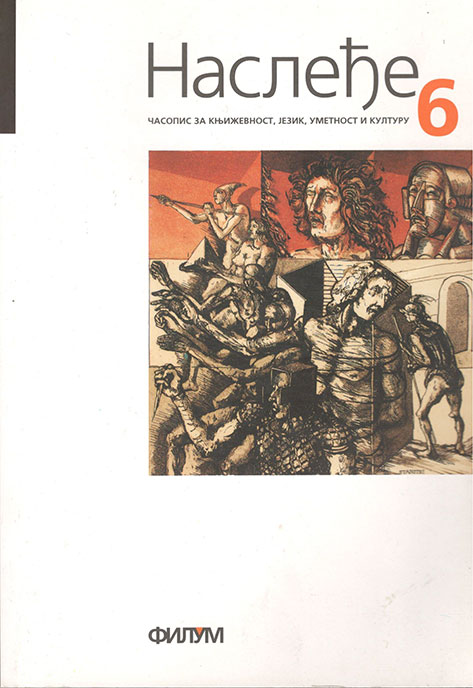САПИР-ВОРФОВА ХИПОТЕЗА, ПРОСТОР И ВРЕМЕ
Кључне речи:
l’hypothèse du déterminisme linguistique, l’espace, le temps, le relativisme linguistique, cadres des référencesСажетак
У овом раду представљам и анализирам радове аутора који су засновали тзв.Хипотезу језичког релативизма, али и модерних истраживача(попут Левинсона)који бране ово лингвистичко и филозофско становиште. Сви ови радови полазе од идеје да говорници тзв.егзотичних језика непоимају на исти начин као ми, говорници индоевропских језика, простор и време.
Референце
– Ašić T. (2004), La représentation cognitive du temps et de l’espace ; étude pragmatique des données linguistiques en français et dans d’autres langues, thèse de doctorat, Institut des Science Cognitives – Université Lyon-2 et Université de Genève.
– Ašić T. (sous presse), Espace, temps, prépositions, Droz, Genève.
– Bohnemeyer J. (2002), The Grammar of Time Reference in Yukatek Maya, Munich, Linkom.
– Casati R. & Varzi A.C. (1995), Holes and Other Superficialities, Cambridge (Mass.), The MIT Press.
– Crystal D. (ed.) (1987), The Cambridge Encyclopedia of Language, Cambridge University Press.
– Eschenbach C. (1999), „Geometric structures of frames of references and natural language semantics”, Spatial Cognition and Computation 1, 329-348.
– Evans N. (1995), A grammar of Kayardild, Berlin, Mouton Grammar Library.
– Hands G. (2001), Darwin. A Beginner’s Guide, London, Hodder & Stoughton.
– Haviland J.B. (1979), „Guugu Yimithirr”, in Dixon R. M. W. & Blake B. (eds), Handbook of Australian Languages, Camberra, Australian Nation University Press, 27-182.
– Haviland J.B. (1993), „Anchoring, iconicity and orientation in Guugu Yimithirr pointing gestures”, Journal of Linguistic Anthropology 3/1, 3-45.
– Jackendoff R. (1985), Semantics and Cognition, Cambridge (Mass.), The MIT Press.
– Levinson S. C. (1983), Pragmatics, Cambridge, Cambridge University Press.
– Levinson S. C. (1996a), „Frames of reference and Molyneux’s question : Crosslinguistic evidence”, in Bloom P., Peterson M. A., Nadel L. & Garrett M. F. (eds), Language and Space, Cambridge (Mass.), The MIT Press, 109-169.
– Levinson S. C. (1996b), „Language and space”, Annual Review of Anthropology 25, 353–382.
– Levinson S. C. (1997), „From outer to inner space : linguistic categories and non-linguistic thinking”, in Nuyts J. & Peterson E. (eds), Language and Conceptualization, Cambridge, Cambridge University Press, 13-45.
– Levinson S. C. (1998), „Studying spatial conceptualization across cultures”, in Danziger E. (ed.), Language, Space, and Culture (Special issue), Ethos. Journal of the Society for Psychological Anthropology 26/1, 7-24.
– Levinson S. C. (2003), Space in Language and Cognition. Explorations in Linguistic Diversity, Cambridge, Cambridge University Press.
– Levinson S. C., Kita S., Haun D. & Rasch B. (2002), „Returning the tables : Language affects spatial reasoning” , Cognition 84, 155-188.
– Lucy J. A. (1992), Language Diversity and Thought. A Reformulation of the Linguistic Relativity Hypothesis, Cambridge, Cambridge University Press.
– Lyons J. (1977), Semantics, Cambridge, Cambridge University Press.
– Malotki E. (1983), Hopi Time. A Linguistic Analysis of Temporal Concepts in the Hopi Language, Berlin, Mouton.
– Ozanne-Rivierre S. (1997), „Spatial reference in New Caledonian languages”, in Senft G. (ed.), Referring to Space. Studies in Austronesian and Papuan Languages, Oxford, Clarendon Press, 82-98.
– Penn J. M. (1972), Linguistic Relativity Versus Innate Ideas, The Hague, Mouton.
– Prince A. S. & Smolensky P. (1993), Optimality Theory. Constraint Interaction in Generative Grammar, Cambridge (Mass.), The MIT Press.
– Sapir E. (1921), Language. An Introduction to the Study of Speech, New York, Harcourt, Brace & Company.
– Whorf B. L. (1956), Language, Thought and Reality. Selected Writings of Benjamin Lee Whorf, Cambridge (Mass.), The MIT Press.
– Whorf B. L. (1969), Linguistique et anthropologie, Paris, Denoël-Gonthier.
– Stanojević V. et Ašić T, (sous presse), „Le concept saussurien et l'opposition conceptuel-procédural”, Actes du colloque sur F de Saussure, Belgrade.
– Ašić T. (sous presse), Espace, temps, prépositions, Droz, Genève.
– Bohnemeyer J. (2002), The Grammar of Time Reference in Yukatek Maya, Munich, Linkom.
– Casati R. & Varzi A.C. (1995), Holes and Other Superficialities, Cambridge (Mass.), The MIT Press.
– Crystal D. (ed.) (1987), The Cambridge Encyclopedia of Language, Cambridge University Press.
– Eschenbach C. (1999), „Geometric structures of frames of references and natural language semantics”, Spatial Cognition and Computation 1, 329-348.
– Evans N. (1995), A grammar of Kayardild, Berlin, Mouton Grammar Library.
– Hands G. (2001), Darwin. A Beginner’s Guide, London, Hodder & Stoughton.
– Haviland J.B. (1979), „Guugu Yimithirr”, in Dixon R. M. W. & Blake B. (eds), Handbook of Australian Languages, Camberra, Australian Nation University Press, 27-182.
– Haviland J.B. (1993), „Anchoring, iconicity and orientation in Guugu Yimithirr pointing gestures”, Journal of Linguistic Anthropology 3/1, 3-45.
– Jackendoff R. (1985), Semantics and Cognition, Cambridge (Mass.), The MIT Press.
– Levinson S. C. (1983), Pragmatics, Cambridge, Cambridge University Press.
– Levinson S. C. (1996a), „Frames of reference and Molyneux’s question : Crosslinguistic evidence”, in Bloom P., Peterson M. A., Nadel L. & Garrett M. F. (eds), Language and Space, Cambridge (Mass.), The MIT Press, 109-169.
– Levinson S. C. (1996b), „Language and space”, Annual Review of Anthropology 25, 353–382.
– Levinson S. C. (1997), „From outer to inner space : linguistic categories and non-linguistic thinking”, in Nuyts J. & Peterson E. (eds), Language and Conceptualization, Cambridge, Cambridge University Press, 13-45.
– Levinson S. C. (1998), „Studying spatial conceptualization across cultures”, in Danziger E. (ed.), Language, Space, and Culture (Special issue), Ethos. Journal of the Society for Psychological Anthropology 26/1, 7-24.
– Levinson S. C. (2003), Space in Language and Cognition. Explorations in Linguistic Diversity, Cambridge, Cambridge University Press.
– Levinson S. C., Kita S., Haun D. & Rasch B. (2002), „Returning the tables : Language affects spatial reasoning” , Cognition 84, 155-188.
– Lucy J. A. (1992), Language Diversity and Thought. A Reformulation of the Linguistic Relativity Hypothesis, Cambridge, Cambridge University Press.
– Lyons J. (1977), Semantics, Cambridge, Cambridge University Press.
– Malotki E. (1983), Hopi Time. A Linguistic Analysis of Temporal Concepts in the Hopi Language, Berlin, Mouton.
– Ozanne-Rivierre S. (1997), „Spatial reference in New Caledonian languages”, in Senft G. (ed.), Referring to Space. Studies in Austronesian and Papuan Languages, Oxford, Clarendon Press, 82-98.
– Penn J. M. (1972), Linguistic Relativity Versus Innate Ideas, The Hague, Mouton.
– Prince A. S. & Smolensky P. (1993), Optimality Theory. Constraint Interaction in Generative Grammar, Cambridge (Mass.), The MIT Press.
– Sapir E. (1921), Language. An Introduction to the Study of Speech, New York, Harcourt, Brace & Company.
– Whorf B. L. (1956), Language, Thought and Reality. Selected Writings of Benjamin Lee Whorf, Cambridge (Mass.), The MIT Press.
– Whorf B. L. (1969), Linguistique et anthropologie, Paris, Denoël-Gonthier.
– Stanojević V. et Ašić T, (sous presse), „Le concept saussurien et l'opposition conceptuel-procédural”, Actes du colloque sur F de Saussure, Belgrade.
Downloads
Објављено
30.06.2007
Како цитирати
Ашић, Т. В. (2007). САПИР-ВОРФОВА ХИПОТЕЗА, ПРОСТОР И ВРЕМЕ. Наслеђе, 4(6), 37–54. преузето од http://35.189.211.7/index.php/nasledje/article/view/74
Bрој часописа
Секција
Студије






